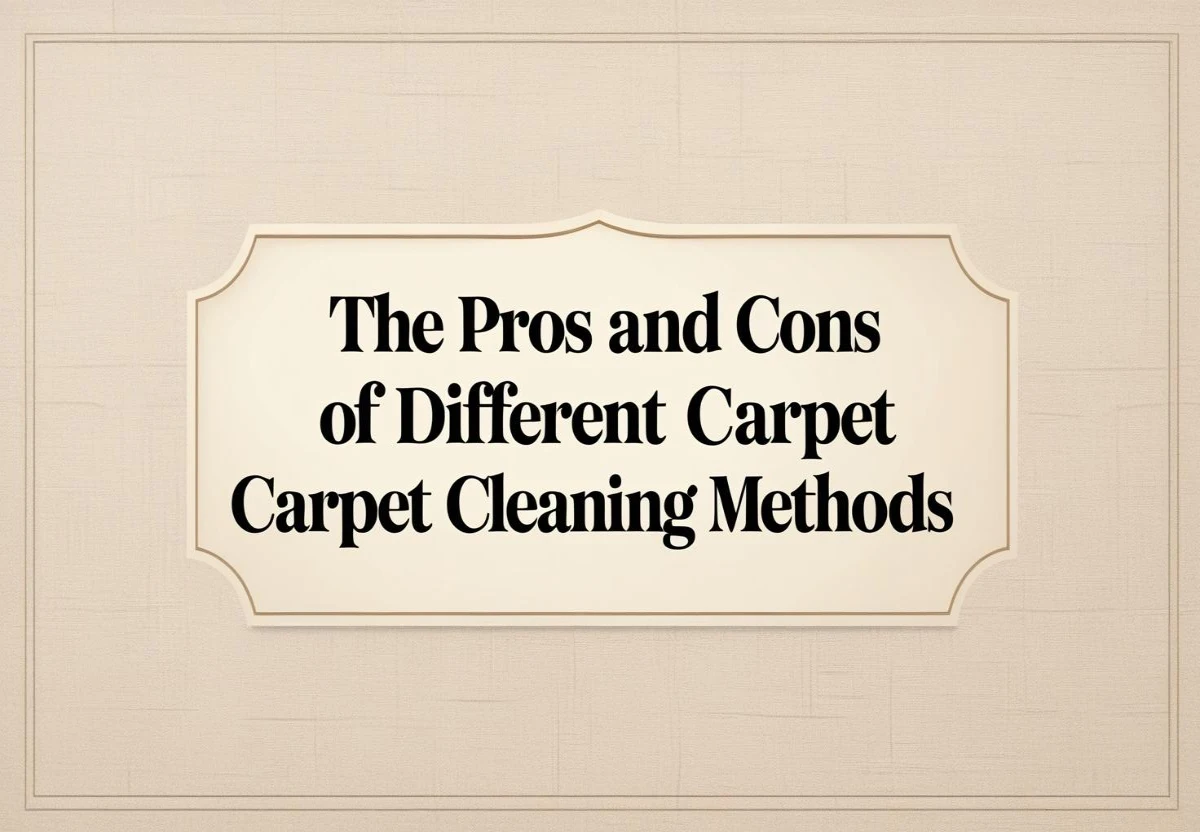When it comes to maintaining your home’s carpets, cleanliness is key. Whether you’re dealing with a home in Portarlington or Mickleham, carpet cleaning in Mickleham or your cities is essential not only for aesthetics but also for the longevity of your carpets. With a variety of methods available, it’s important to understand the pros and cons of each to choose the best one for your needs.

Hot Water Extraction (Steam Cleaning)
Hot water extraction, commonly known as steam cleaning, is one of the most popular carpet cleaning methods. It uses high-pressure hot water to loosen dirt and grime, which is then vacuumed away.
How It Works
In steam cleaning, hot water is sprayed onto the carpet. The water is then extracted, along with the dirt, through a powerful vacuum. Some systems use steam to help with the extraction process, which is why it’s often called “steam cleaning.”
Pros of Hot Water Extraction
-
Deep Cleaning: Steam cleaning offers a thorough clean, removing dirt, allergens, and bacteria deep within the fibres.
-
Health Benefits: This method is ideal for people with allergies since it eliminates dust mites and other allergens.
-
Effective Stain Removal: It works well on stubborn stains that other methods can’t remove.
Cons of Hot Water Extraction
-
Long Drying Time: After steam cleaning, carpets can take 6-8 hours to dry completely, which can be inconvenient.
-
Requires Professional Help: While DIY machines are available, hiring a professional ensures a deeper, more effective clean.
Dry Cleaning
Dry cleaning is another method that’s gaining popularity, particularly for those who need a quick clean. It involves using a cleaning compound applied to the carpet, which is then agitated and vacuumed up.
How Dry Cleaning Works
A powder or liquid cleaning agent is applied to the carpet. It’s worked into the carpet fibres with a machine, then extracted using a vacuum.
Benefits of Dry Cleaning
-
Quick Drying: Dry cleaning typically takes only a few hours to dry, making it ideal for busy households.
-
No Water: If you’re concerned about water damage or humidity, dry cleaning may be a better option.
-
Gentle on Carpets: This method is less harsh, so it can be used on delicate carpets.
Drawbacks of Dry Cleaning
-
Surface Cleaning Only: Dry cleaning doesn’t clean deep within the carpet fibres, so it may not be as effective on heavy dirt or stains.
-
Chemical Residue: Some dry cleaning solutions may leave residue behind, which can attract more dirt over time.
Bonnet Cleaning
Bonnet cleaning is often used in commercial settings but can also be used in homes. It involves using a rotary machine with an absorbent pad to scrub the surface of the carpet.
The Process of Bonnet Cleaning
A cleaning solution is applied to the carpet, and the bonnet pad is used to agitate the solution and lift dirt.
Advantages of Bonnet Cleaning
-
Quick and Efficient: This method is fast and works well for routine maintenance.
-
Cost-Effective: Bonnet cleaning is typically cheaper than other methods.
Disadvantages of Bonnet Cleaning
-
Not Deep Cleaning: It only cleans the top layer of the carpet, which means deeper dirt and stains may be missed.
-
Carpet Wear: The rotating pad can cause friction on the carpet fibres, potentially leading to wear over time.
Shampooing
Shampooing carpets is a more traditional method and involves using a carpet shampooer that applies a cleaning solution to the carpet, followed by agitating and vacuuming the solution.
What Is Shampooing?
Shampooing works by applying a foamy cleaning agent to the carpet. This foam loosens dirt and stains, which are then vacuumed away.
Pros of Shampooing Carpets
-
Cost-Effective: This is one of the more affordable cleaning methods.
-
Effective on Stains: It works well for removing surface stains and dirt.
Cons of Shampooing Carpets
-
Residue Build-Up: Leftover shampoo can attract dirt and cause carpets to look dirty again quickly.
-
Long Drying Time: Similar to steam cleaning, shampooing can also leave carpets damp for hours.
Encapsulation
Encapsulation is a relatively new method where synthetic detergents crystallise dirt and soil, which is then vacuumed up.
How Encapsulation Works
A cleaning solution is applied to the carpet, and the dirt is encapsulated in crystals. The crystals are then vacuumed away, leaving the carpet clean.
Benefits of Encapsulation
-
Quick Drying: Like dry cleaning, encapsulation offers a faster drying time.
-
Environmentally Friendly: It uses less water than other methods, making it a more sustainable choice.
Disadvantages of Encapsulation
-
Surface Cleaning: While effective, it doesn’t penetrate deep into the fibres for a thorough clean.
-
Not Ideal for Heavily Soiled Carpets: Encapsulation may not be as effective on carpets that are heavily soiled.
Carpet Cleaning in Portarlington: What to Consider
Portarlington homes are often exposed to coastal elements, so carpet cleaning here requires consideration of salt, sand, and moisture. The ideal method of carpet cleaning in Portarlington depends on the specific needs of the household. For instance, steam cleaning could be highly effective in homes that experience high humidity, as it can help to eliminate allergens and deep-seated dirt.
Carpet Cleaning in Mickleham: What to Consider
Mickleham, with its mix of rural and suburban properties, may face different carpet cleaning challenges. If your home in Mickleham has a lot of foot traffic or pets, methods like dry cleaning or bonnet cleaning might be ideal for a quick freshen-up. However, for a deep clean, steam cleaning is likely the best choice.
Factors to Consider When Choosing a Cleaning Method?
Choosing the right carpet cleaning method depends on various factors:
-
Type of Carpet: Some carpets are delicate and require gentle cleaning methods, while others can handle more aggressive cleaning.
-
Carpet Age and Condition: Older carpets may benefit from a deeper clean to restore their appearance.
-
Health Concerns: For households with allergies or asthma, methods like steam cleaning may help in removing dust mites and allergens.
-
Environmental Impact: Eco-friendly cleaning solutions are available for those concerned about sustainability.
How Often Should You Clean Your Carpet?
The frequency of carpet cleaning depends on factors like household traffic, pets, and allergies. As a general rule:
-
High-Traffic Areas: Every 6 to 12 months.
-
Low-Traffic Areas: Every 12 to 18 months.
Professional vs. DIY Carpet Cleaning
While DIY carpet cleaning can save you money, professional cleaning services ensure a more thorough, long-lasting clean. Professionals have access to more powerful equipment and cleaning solutions, providing a deeper clean than what most DIY machines can achieve.
Common Mistakes to Avoid in Carpet Cleaning
-
Over-Wetting Carpets: Too much moisture can cause mildew and damage carpets.
-
Using Harsh Chemicals: Some cleaning products may cause discoloration or fibre damage.
How to Maintain Your Carpet Post-Cleaning?
After cleaning, vacuum regularly, avoid excessive dirt, and use rug pads to protect high-traffic areas. Routine care will help extend the life of your carpet.
Conclusion
Each carpet cleaning method has its pros and cons. Hot water extraction offers deep cleaning, while dry cleaning provides quick results with minimal drying time. Bonnet cleaning is perfect for regular maintenance, and shampooing can be effective for surface stains. Encapsulation is another environmentally friendly option for quick cleans. When selecting the right method, consider your carpet’s material, condition, and the amount of traffic it sees.

